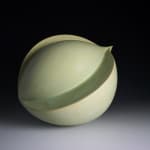Suhama Tomoko 須浜智子 Japanese, b. 1965
H30 x D33 x W33cm
Further images
What can the sense of touch teach us about nature? Can touch be explored on a microscopic level? Such questions immediately confront you when viewing Suhama Tomoko's work. Her ceramic sculptures take on the forms of plants under a microscope, their cells pulsating with life. Suhama's work is undeniably alive, reminding us that ceramic sculpture itself is made with clay given to us by nature.
Suhama grew up in the countryside, which is the source of inspiration for works like "ONION". The onion-shaped sculpture is playful, approachable, almost huggable in its gentle celadon dues. This sculpture tempts us with matte textures, inviting us to reach forward and touch. Suhama has described her creative process as tending a garden and this piece is a playful member of the artist's verdant plot. Who could have guessed that onions carry such delight and elegance!
Haptic theory, which explores how touch can shape our (often visual) experiences, is a bit of a buzz word for art critics and theorists at the moment. Suhama's oeuvre throws contemporary Japanese ceramics into these discussions, as ceramic sculptures are often made to be held and felt. While some artists revel in the textures resulting from the naturally-unpredictable ceramic process, Suhama's sculptures show precision.
Each sculpture is so smooth that it speaks of the execution of a machine. And yet, Suhama reminds us, nature produces some of the most flawless surfaces, like a sculpture mimicking the perfection of a cell under a microscope. It is no surprise that her work can be enjoyed in the Morikami Museum and Japanese Gardens, as well as the Museum of Ceramic Art in her hometown Hyogo.











